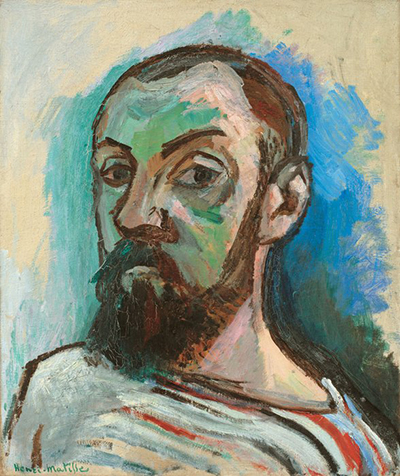The early 20th century was a particularly prolific period for Henri Matisse, marked by his work within the Fauvist movement. The bright colour schemes associated with that style can be found within the self portrait included here.
Here we find Henri was a serious expression on his face, as he appears directly at the viewer. He sports a striped t-shirt which has a wide collar that reveals part of his shoulder. His beard at this stage was long but well groomed, still perfectly brown, though his hair is clearly starting to recede. He would have been approaching his forties at the time of this artwork but is still fairly well presented, almost fashionable when considering the brightly coloured stripes that cover his upper half. It is always possible that elements of this scene were not actually present at the time of the sitting because we not that happened in other Matisse portraits, such as in Woman with a Hat, where originally a black dress was actually worn, and then much brighter tones were added later by Matisse himself.
This is a relatively small artwork, measuring 46cm wide by 55cm tall. It can now be found at the Statens Museum for Kunst, Copenhagen. Their collection focuses on Danish and French art specifically, though with some other European nations also featured from time to time. They also own Portrait of Madame Matisse (The green line), 1905, which provides the perfect accompaniment to sit alongside this self portrait. Some of the artists and paintings also featured here include Venus and Cupid, the Honey Thief, The Judgement of Paris and also The Stag Hunt of the Elector Frederic the Wise of Saxony by Lucas Cranach. Additionally there are related works from Pieter Bruegel the Younger, a skilled painter who took the mantle of his father and continued the family's success in the art world. They also have another Matisse painting in Le Luxe II from 1907-1908.
It is believed that only four self-portraits exist from this artist's career, with the other three being in the at-work genre, where he is accompanied by some of his artistic tools and is posed as if working. That makes this portrait particularly unique and also helps us to learn a little more about the man behind some of the most influential contemporary art in the 20th century. It was also timed just at the start of his work within the Fauvist movement, perhaps within the first year of its inception, giving us an insight into the raw ideas that they held which would later be amended and tweaked as the group developed in the next few years. His facial expression is perhaps typical of an artist, in that he gives nothing away and then challenges himself to work around that restriction.




